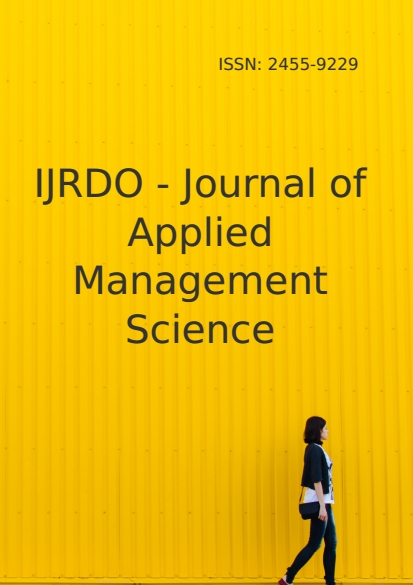Opportunity and Worker Commitment in Oil Servicing Companies in Bayelsa State, Nigeria
Abstract
This study adopted descriptive statistics design and covered a population of 1400 workers of oil servicing companies in Bayelsa State, Nigeria. Data was generated through a five point Likert scale questionnaire designed and the formulated researches Hypotheses were tested using the Spearman’s Rank Order Correlation Coefficient statistical tool. The outcome of the test revealed that there are significant relationships between opportunity and the measures of worker commitment (affective commitment, normative commitment and continuance commitment).with the aid of the SPSS version (21.0) of statistical package for social sciences. The conclusion was drawn on the fact that organizations should begin to identify opportunity/career development beyond just once event or an act to incentivize employees. They should see it as a continuous process and a strategic activity of the human resource department that can ensure the attainment of both the economic and psycho-social needs of the employees with the profit and sustainable goals of the organization.
Downloads
References
Agba, A. M. O., Nkpoyen, F. & Ushie, E. M. (2010).Career development and employees commitment inindustrial organizations in Calabar, Nigeria. American Journal of Scientific and Industrial Research, 1(2), 105-114.
Ahiauzu, A., & Asawo, S.P. (2009). Altruistic love, culture and worker commitment in the Nigerian Manufacturing industry. A study in workplace spirituality. In Sigue’s (ed) repositioning African business and development for the 21st century: A paper presented on the proceedings of the 10th Annual Conference IAABD, 351 – 358.
Akintayo, S. I. (2010). Work-family role conflict and employee commitment among industrial workers in Nigeria. Journal of Psychology and Counselling 2(1),1-8.
Armstrong M. (2001). A Handbook of Human Resource Management Practice (8th ed.). London: Kogan Page.
Bandura, A. (1977). Social learning theory. Englewood Cliffs, NJ: Prentice-Hall.
Bandura, A. (1997). Self-efficacy: The exercise of control. New York: Freeman.
Cappelli P. and Hamori M. (2005). The New Steps to Career Advancement.
Chandrasekar, K. (2011). Workplace environment and its impact on organizational performance in public sector organizations. International of enterprise computing and business systems.1(1) 1-19.
Chen, Y. (2010). The drivers of green brand equity: green brand image, green satisfaction and green trust. Journal of Business Ethics, 93(2), 471-486.
Dawis, R. V. (1992). The individual difference tradition in counseling psychology. Journal of Counseling Psychology, 39, 7–19.
Dawis, R. V. (2005). The Minnesota theory of work adjustment. In S. D. Brown & R. T. Lent (Eds.), Career development and counseling: Putting theory and research to work (pp. 3– 23). Hoboken, NJ: Wiley.
Decenzo, David A. and Robbins, Stephen P. (2002). Human Resource Management. US Prentice Hall.
Gillie, Scott and Isenhour, Meegan G (2003). The Educational, Social, and Economic Value of Informed and Considered Career Decisions. America’s Career Resource Network Association, Research – based Policy Guidelines.URL:http;//www.cis.idaho.gov. Portals/45/Documents/InformedCareerDecisions.ppt.
Gomez-Mejia, L., Balkin, D. and Cardy, R (2008). Management: People, Performance, Change. (3rd ed.). New York: McGraw-Hill.
Ogba, I. (2009). Commitment in the workplace. The impact of income and age on employee commitment in Nigerian banking sector: Management Research News, 31(11), 867-878.
Onuka C. A. (2012). Commitment in an organization. Journal of Social Psychology. 4(5), 160- 170.
Romzek, B. S., (1990). Employee investment and commitment: The Ties That Bind. Public Administration Review, 50, 374−382.
Rosenthal, R. (1990). Replication in behavioural research. Journal of Social Behaviour and Personality, 5, 1-30.
Rowe, A.J., & Boulgarides, J.D. (1992). Managerial Decision Making. New York: Macmillan Publishing Company.
Scholarios, D., & Marks, A. (2006). Work-life balance and the software worker: Human Resource Management Journal, 14(2),54-74.
Serensen, J.B. (2002). The strength of corporate culture and the reliability of firm performance: Business services industry. 8(16).
Shore, L.M., Tetrick, L.E., Lynch, P., & Barkdale, K. (2006). Social and economic exchange, construct development and calidation: Journal of Applied Social Psychology, 36, 837-867.
Spector, P.E.,(1997). Job satisfaction: Application, Assessment, Causes, and Consequences. London :Sage Publication, Inc.
Steijn, B., & Leisink, P. (2006). Organizational commitment among dutch public sector employees. International Review of Administrative Sciences, 72, 187−201.
Telly, C., French, W., & Scott, W. (1971). The relationship of inequity to turnover among hourly workers. Administrative Science Quarterly, 16(2), 164.
Thompson, M. (2002). High Performance work organization in U.K aerospace, London: The society of British aerospace companies. 60(2).
Vandenberghe, C. (2004). Employee commitment and motivation. Journal of Applied Psychology, 89, 991−1007.
Whitt, W., (2006). The impact of increased employee retention on performance in a customer
contact centre. Manufacturing and Service Operation Management, 8(3), 235-252.
Wilde, E. (2003). Career management can end discontent. http://www.personneltoday.com/articles2003/04/19/29344/ Careermanagementcafnfendfdiscontent.htm. Retrieved on 2nd July, 2019.
WorldatWork, (2000). Total rewards, from strategy to implementation, WorldatWork: Scottsdale, AZ.
Zeb-Obipi, I. & Agada, J.T. (2017). Workplace social programmes and employee commitment: A literary reflection. IOSR Journal of Business and Management, 20 (1) 09-16.
Zin, R. M. (2004). Perception of professional engineers toward quality of work life and organizational commitment. International Journal of Business, 6(3), 323- 334.
Zweni, T. (2004). An assessment of the impact of the organizational restructuring on the morale of employees at a selected final institution. Nelson Mandela Metropolitan University: South Africa.
Copyright (c) 2020 IJRDO - Journal of Applied Management Science (ISSN: 2455-9229)

This work is licensed under a Creative Commons Attribution-NonCommercial-NoDerivatives 4.0 International License.
Author(s) and co-author(s) jointly and severally represent and warrant that the Article is original with the author(s) and does not infringe any copyright or violate any other right of any third parties, and that the Article has not been published elsewhere. Author(s) agree to the terms that the IJRDO Journal will have the full right to remove the published article on any misconduct found in the published article.





